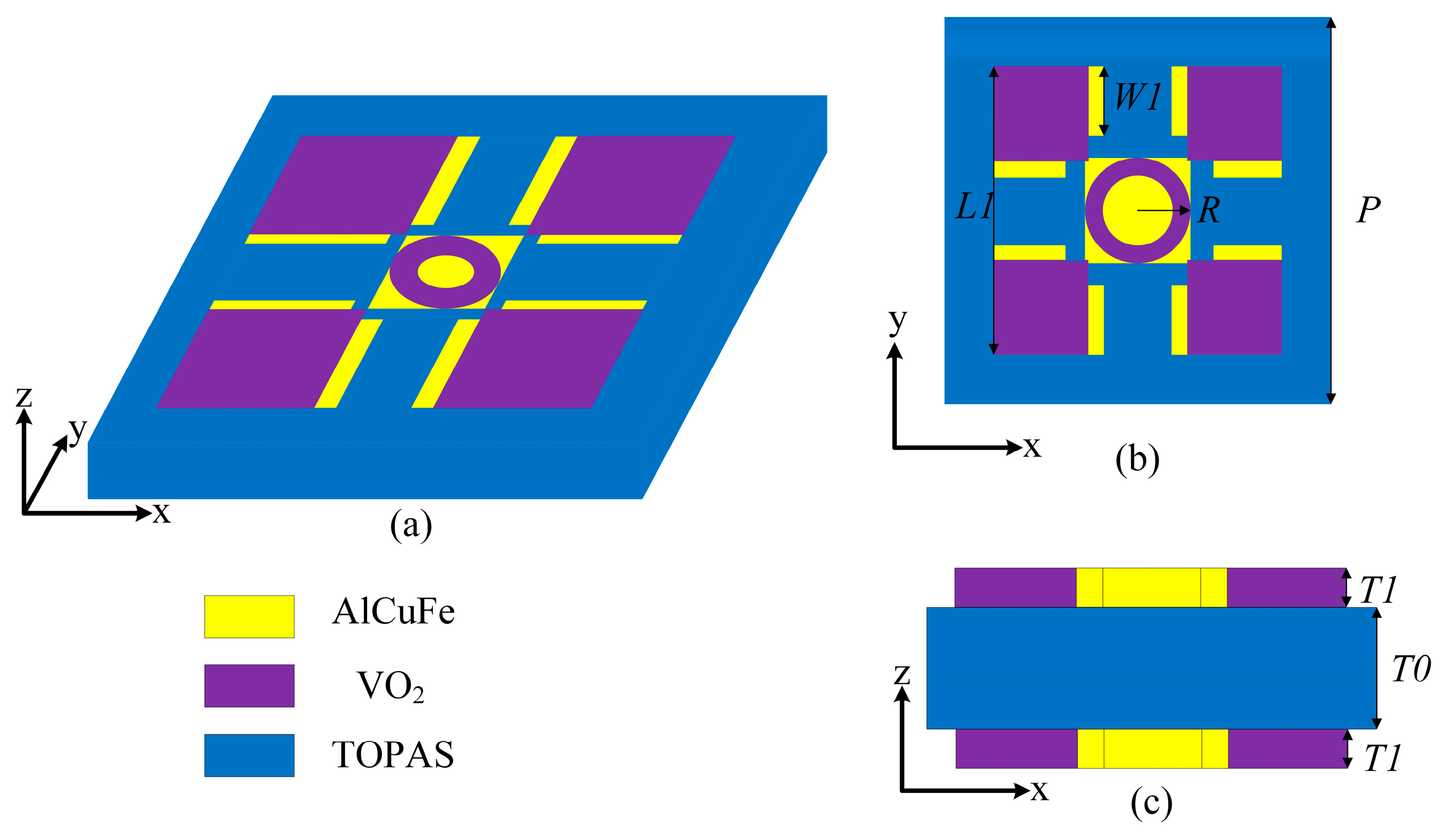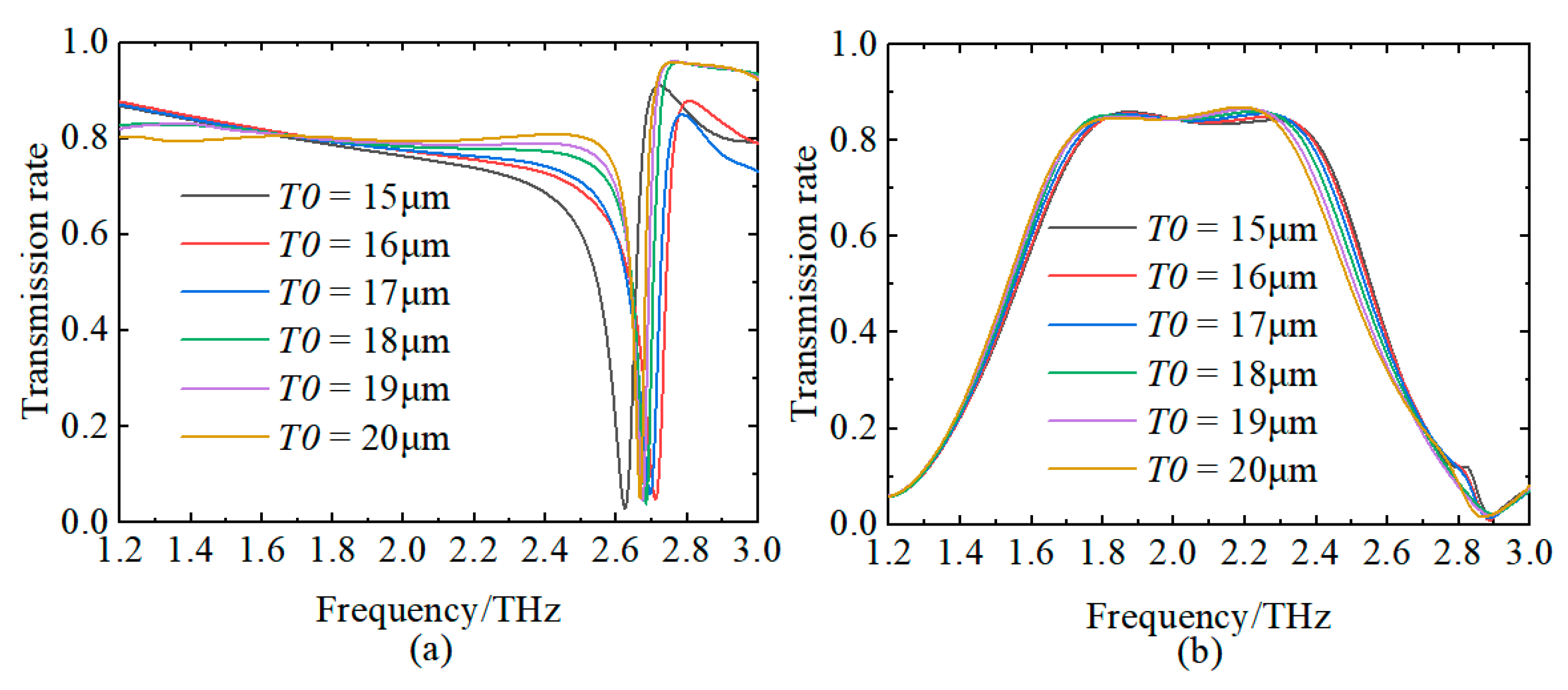Design and Numerical Modeling of Terahertz Metasurface with Dual Functions of Sensing and Filtering
Abstract
:1. Introduction
2. Device Design
3. Results and Discussion
3.1. Sensing Element
3.2. Band-Pass Filter
3.3. The Impact of Parameters
4. Conclusions
Author Contributions
Funding
Institutional Review Board Statement
Informed Consent Statement
Data Availability Statement
Conflicts of Interest
References
- Tonouchi, M. Cutting-edge terahertz technology. Nat. Photonics 2007, 1, 97–105. [Google Scholar] [CrossRef]
- Karl, N.J.; McKinney, R.W.; Monnai, Y.; Mendis, R.; Mittleman, D.M. Frequency-division multiplexing in the terahertz range using a leaky-wave antenna. Nat. Photonics 2015, 9, 717–720. [Google Scholar] [CrossRef]
- Chen, Z.; Zhang, B.; Zhang, Y.; Yue, G.R.; Fan, Y.; Yuan, Y. 220 GHz outdoor wireless communication system based on a Schottky-diode transceiver. IEICE Electron. Expr. 2016, 13, 20160282. [Google Scholar] [CrossRef]
- Valušis, G.; Lisauskas, A.; Yuan, H.; Knap, W.; Roskos, H. Roadmap of terahertz imaging 2021. Sens. Elem. 2021, 21, 4092. [Google Scholar] [CrossRef] [PubMed]
- Markelz, A.G.; Mittleman, D.M. Perspective on terahertz applications in bioscience and biotechnology. ACS Photonics 2022, 9, 1117–1126. [Google Scholar] [CrossRef]
- Li, Y.; Xie, C.Z.; Gou, B.; Yu, S.; Yang, C. Terahertz detection of interface defects within composite insulators using a gated recurrent neural network. IEEE Trans. Dielectr. Electr. Insul. 2023, 31, 704–712. [Google Scholar] [CrossRef]
- Veselago, V.G. The electrodynamics of substances with simultaneously negative values of and μ. Sov. Phys. Uspekhi 1968, 10, 509. [Google Scholar] [CrossRef]
- Smith, D.R.; Pendry, J.B.; Wiltshire, M.C.K. Metamaterials and negative refractive index. Science 2004, 305, 788–792. [Google Scholar] [CrossRef] [PubMed]
- Zang, X.F.; Yao, B.S.; Chen, L.; Xie, J.Y.; Guo, X.G.; Balakin, A.V.; Shkurinov, A.P.; Zhuang, S.L. Metasurfaces for manipulating terahertz waves. Light Adv. Manuf. 2021, 2, 148. [Google Scholar] [CrossRef]
- Deng, Y.D.; Cai, Z.R.; Ding, Y.T.; Bozhevolnyi, S.I.; Ding, F. Recent progress in metasurface-enabled optical waveplates. Nanophotonics 2022, 11, 2219–2244. [Google Scholar] [CrossRef]
- Baek, J.; Kim, J.; Seol, J.H.; Kim, M. All-dielectric polarization-sensitive metasurface for terahertz polarimetric imaging. Sci. Rep. 2024, 14, 7544. [Google Scholar] [CrossRef] [PubMed]
- Wang, Y.L.; Zhao, C.; Wang, J.J.; Luo, X.; Xie, L.J.; Zhan, S.J.; Kim, J.M.; Wang, X.Z.; Liu, X.J.; Ying, Y.B. Wearable plasmonic-metasurface sensing element for noninvasive and universal molecular fingerprint detection on biointerfaces. Sci. Adv. 2021, 7, eabe4553. [Google Scholar] [CrossRef] [PubMed]
- Qin, J.; Jiang, S.B.; Wang, Z.S.; Cheng, X.B.; Li, B.J.; Shi, Y.Z.; Tsai, D.P.; Liu, A.Q.; Huang, W.; Zhu, W.M. Metasurface micro/nano-optical sensing elements: Principles and applications. ACS Nano 2022, 16, 11598–11618. [Google Scholar] [CrossRef]
- Lin, S.J.; Liu, W.T.; Hou, X.H.; Peng, Z.Y.; Chen, Z.C.; Hu, F.R. Specific detection of n-propanol gas via terahertz metasurface sensing element modified by molecularly imprinted polymer. Spectrochim. Acta Part. A Mol. Biomol. Spectrosc. 2023, 292, 122413. [Google Scholar] [CrossRef] [PubMed]
- Liu, H.; Wang, K.; Gao, J.X.; Liu, M.; Zhang, H.Y.; Zhang, Y.P. Dirac semimetal and an all dielectric based tunable ultrasensitive terahertz sensing element with multiple bound states in the continuum. Opt. Express 2022, 30, 46471–46486. [Google Scholar] [CrossRef] [PubMed]
- Patel, S.K.; Surve, J.; Parmar, J. Detection of cancer with graphene metasurface-based highly efficient sensing elements. Diam. Relat. Mater. 2022, 129, 109367. [Google Scholar] [CrossRef]
- Zhao, S.L.; Wang, J.Y.; Jiang, H.; Zhang, H.; Zhao, W.R. Implementing the dual functions of switchable broadband absorption and sensitive sensing in a VO2-based metasurface. Plasmonics 2023, 18, 2041–2047. [Google Scholar] [CrossRef]
- Kotov, O.V.; Lozovik, Y.E. Dielectric response and novel electromagnetic modes in three-dimensional Dirac semimetal films. Phys. Rev. B 2016, 93, 235417. [Google Scholar] [CrossRef]
- Li, Z.Y.; Yi, Z.; Liu, T.T.; Liu, L.; Chen, X.F.; Zheng, F.S.; Zhang, J.G.; Li, H.L.; Wu, P.H.; Yan, P.G. Three-band perfect absorber with high refractive index sensing based on an active tunable Dirac semimetal. Phys. Chem. Chem. Phys. 2021, 23, 17374–17381. [Google Scholar] [CrossRef]
- Wang, X.Y.; Lin, J.C.; Yan, Z.Y.; Yi, Z.; Yu, J.X.; Zhang, W.; Qin, F.; Wu, X.W.; Zhang, J.G.; Wu, P.H. Tunable high-sensitivity sensing detector based on Bulk Dirac semimetal. RSC Adv. 2022, 12, 32583–32591. [Google Scholar] [CrossRef] [PubMed]
- Hou, B.; Li, Z.Y.; He, L.; Yi, Z.; Song, Q.J.; Yang, H.; Yi, Y.G.; Li, H.L. Enhanced quasi-BIC refractive index sensing based on controlling the Fermi energy of Dirac semimetal metasurface. Opt. Laser Technol. 2023, 164, 109537. [Google Scholar] [CrossRef]
- Driscoll, T.; Kim, H.; Chae, B.; Kim, B.; Lee, Y.; Jokerst, N.M.; Palit, S.; Smith, D.R.; Di Ventra, M.; Basov, D.N. Memory Metamaterials. Science 2009, 325, 1518–1521. [Google Scholar] [CrossRef] [PubMed]
- Wang, T.L.; Zhang, H.Y.; Zhang, Y.; Zhang, Y.P.; Cao, M.Y. Tunable bifunctional terahertz metamaterial device based on Dirac semimetals and vanadium dioxide. Opt. Express 2020, 28, 17434. [Google Scholar] [CrossRef] [PubMed]
- Yi, N.N.; Zong, R.; Qian, R.R. Multifunctional terahertz metasurface utilizing Dirac semi-metal and vanadium dioxide hybrid metamaterials. Mat. Sci. Semicon. Proc. 2022, 146, 106682. [Google Scholar] [CrossRef]
- Zhang, Y.G.; Zhang, R.; Liang, L.J.; Yao, H.Y.; Yan, X.; Huang, C.C.; Ying, K.H. Multifunctional terahertz absorber based on the Dirac semimetal and vanadium dioxide. Appl. Opt. 2023, 62, 813–819. [Google Scholar] [CrossRef] [PubMed]
- Asl, A.B.; Rostami, A.; Amiri, I.S. Terahertz band pass filter design using multilayer metamaterials. Opt. Quant. Electron. 2020, 52, 155. [Google Scholar] [CrossRef]
- Pitchappa, P.; Kumar, A.; Singh, R.; Wang, N. Electromechanically tunable frequency-agile metamaterial bandpass filters for terahertz waves. Adv. Opt. Mater. 2022, 10, 2101544. [Google Scholar] [CrossRef]
- Wu, P.J.; Tsai, W.C.; Yang, C.S. Electrically tunable graphene-based multi-band terahertz metamaterial filters. Opt. Express 2023, 31, 469–478. [Google Scholar] [CrossRef] [PubMed]
- Zhang, L.; Chen, Z.; Sun, C.Y.; Zhao, Y.Y.; Sun, H.Y.; Xu, Y.P.; Huang, Z.Y. A terahertz filter/sensing element design based on vanadium dioxide and Dirac semimetals. Acta Opt. Sin. 2024, 44, 0223001. [Google Scholar]
- Han, J.Z.; Chen, R.S. Tunable broadband terahertz absorber based on a single-layer graphene metasurface. Opt. Express 2020, 28, 30289–30298. [Google Scholar] [CrossRef] [PubMed]
- Zhang, J.; Tao, S.; Yan, X.; Zhang, X.; Guo, J.; Wen, Z. Dual-frequency polarized reconfigurable terahertz antenna based on graphene metasurface and TOPAS. Micromachines 2021, 12, 1088. [Google Scholar] [CrossRef] [PubMed]
- Cunningham, P.D.; Valdes, N.N.; Vallejo, F.A.; Hayden, L.M.; Polishak, B.; Zhou, X.H.; Luo, J.; Jen, A.K.Y.; Williams, J.C.; Twieg, R.J. Broadband terahertz characterization of the refractive index and absorption of some important polymeric and organic electro-optic materials. J. Appl. Phys. 2011, 109, 043505–043505-5. [Google Scholar] [CrossRef]
- Darvishi Bahloli, M.; Bordbar, A.; Basiri, R.; Jam, S. A tunable multi-band absorber based on graphene metasurface in terahertz band. Opt. Quantum Electron. 2022, 54, 708. [Google Scholar] [CrossRef]
- Wang, C.; Tan, S.; Lin, X.; Chen, H.; Gao, F. Terahertz plasmonic metagrating design simultaneously enabling broadband extraordinary transmission and field enhancement. Prog. Electromagn. Res. 2023, 177, 85–94. [Google Scholar] [CrossRef]
- Ding, F. A Review of Multifunctional Optical Gap-Surface Plasmon Metasurfaces. Prog. Electromagn. Res. 2022, 174, 55–73. [Google Scholar] [CrossRef]
- He, P.H.; Zhang, H.C.; Zhu, J.W.; Hu, M.; Cui, T.J. Miniaturized Photonic and Microwave Integrated Circuits Based on Surface Plasmon Polaritons. Prog. Electromagn. Res. 2022, 175, 105–159. [Google Scholar]
- Liu, L.; Li, Z. Spoof surface plasmons arising from corrugated metal surface to structural dispersion waveguide. Prog. Electromagn. Res. 2022, 173, 93–127. [Google Scholar] [CrossRef]
- Wang, S.; Kang, L.; Werner, D.H. Hybrid resonators and highly tunable terahertz metamaterials enabled by vanadium dioxide (VO2). Sci. Rep. 2017, 7, 4326. [Google Scholar] [CrossRef] [PubMed]
- Liu, W.; Song, Z. Terahertz absorption modulator with largely tunable bandwidth and intensity. Carbon 2021, 174, 617–624. [Google Scholar] [CrossRef]
- Wen, C.; Feng, L.; Li, Z.; Bai, J.; Wang, S.; Gao, X.; Wang, J.; Yao, W. A review of the preparation, properties and applications of VO2 thin films with the reversible phase transition. Front. Mater. 2024, 11, 1341518. [Google Scholar] [CrossRef]
- Huang, H.F.; Huang, H.M. Millimeter-wave wideband high efficiency circular Airy OAM multibeams with multiplexing OAM modes based on transmission metasurfaces. Prog. Electromagn. Res. 2022, 173, 151–159. [Google Scholar] [CrossRef]
- Yuan, S.; Yang, J.; Wang, Y.; Chen, Y.; Zhou, X. Highly Sensitive Temperature Sensing via Photonic Spin Hall Effect. Prog. Electromagn. Res. 2023, 177, 31–32. [Google Scholar] [CrossRef]
- Al-Naib, I. Thin-film sensing via fano resonance excitation in symmetric terahertz metamaterials. J. Infrared Milli. Terahz. Waves 2018, 39, 1–5. [Google Scholar] [CrossRef]
- Tu, D.; Wu, Y.; Xie, J.; Zang, X.; Ding, L.; Chen, L. Switchable Fano Resonance Based on Cut-Induced Asymmetric Split-Ring Resonators with Dirac Semimetal Film. Plasmonics 2021, 16, 1405–1415. [Google Scholar] [CrossRef]
- Zhuang, H.; Ding, W.; Tan, H.; Tian, C.; Kong, F. Terahertz Plasmonic Sensing element based on bulk Dirac Semimetals. Opt. Quant. Electron. 2023, 55, 390. [Google Scholar] [CrossRef]
- Sarabandi, K.; Behdad, N. A frequency selective surface with miniaturized elements. IEEE Trans. Antennas Propag. 2007, 55, 1239–1245. [Google Scholar] [CrossRef]














Disclaimer/Publisher’s Note: The statements, opinions and data contained in all publications are solely those of the individual author(s) and contributor(s) and not of MDPI and/or the editor(s). MDPI and/or the editor(s) disclaim responsibility for any injury to people or property resulting from any ideas, methods, instructions or products referred to in the content. |
© 2024 by the authors. Licensee MDPI, Basel, Switzerland. This article is an open access article distributed under the terms and conditions of the Creative Commons Attribution (CC BY) license (https://creativecommons.org/licenses/by/4.0/).
Share and Cite
Zhang, L.; Sun, H.; Chen, Z.; Tang, R.; Yang, J.; Li, W. Design and Numerical Modeling of Terahertz Metasurface with Dual Functions of Sensing and Filtering. Sensors 2024, 24, 4823. https://doi.org/10.3390/s24154823
Zhang L, Sun H, Chen Z, Tang R, Yang J, Li W. Design and Numerical Modeling of Terahertz Metasurface with Dual Functions of Sensing and Filtering. Sensors. 2024; 24(15):4823. https://doi.org/10.3390/s24154823
Chicago/Turabian StyleZhang, Lu, Huayan Sun, Zhe Chen, Runfeng Tang, Jinxiao Yang, and Weilin Li. 2024. "Design and Numerical Modeling of Terahertz Metasurface with Dual Functions of Sensing and Filtering" Sensors 24, no. 15: 4823. https://doi.org/10.3390/s24154823





